Every day this month I am looking back on the 10 years since I started this blog in June, 2008. Part 6 is this one — Harvesting Coriander Seed — from October 2009. It's my second "top rating" post of all-time, in terms of the number of people who have read it.
As the weather warms up in our Aussie spring, coriander (or cilantro if you prefer that name) gets seriously seedy. This herb isn't really worth bothering to grow in our hot summers. But it is worth harvesting the seeds now, and that's what I've been doing this morning. However, I have also been tracing the plant's progress from leafy to flowery to seedy with my camera, and I thought I'd celebrate this quite beautiful little event.
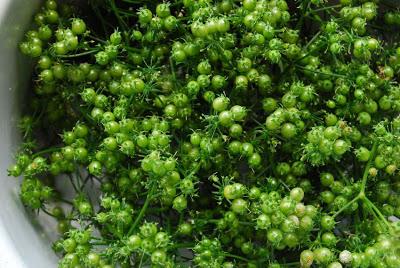 Freshly harvested green coriander seeds. They smell nice but do look a bit like a insect-egg colony when clustered in a bowl like this.
Freshly harvested green coriander seeds. They smell nice but do look a bit like a insect-egg colony when clustered in a bowl like this. Just a few weeks ago they were just a bunch of small but pretty flowers.
Just a few weeks ago they were just a bunch of small but pretty flowers.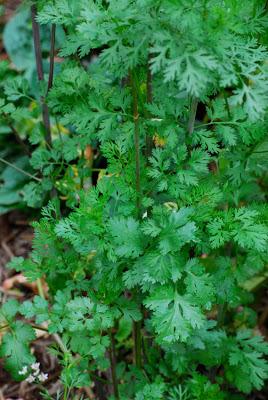 And a few weeks before that you could tell that the seed-making season had arrived. The broad leaves we use for cooking were giving way to the fine, spindly leaves of coriander that's about to go to seed. Once you see those skinny leaves, your coriander is on the way out.
And a few weeks before that you could tell that the seed-making season had arrived. The broad leaves we use for cooking were giving way to the fine, spindly leaves of coriander that's about to go to seed. Once you see those skinny leaves, your coriander is on the way out.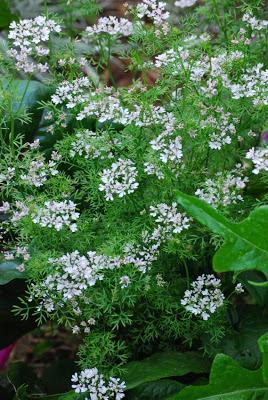 When the whole plant is in flower it looks like a blowsy cottage garden perennial (or at least from a distance it does), and it still smells as nice as ever if you happen to brush past it while weeding or harvesting other vegies or herbs.
When the whole plant is in flower it looks like a blowsy cottage garden perennial (or at least from a distance it does), and it still smells as nice as ever if you happen to brush past it while weeding or harvesting other vegies or herbs. While the flowers, from a distance, look white, up close the buds have a stronger pinkish tinge.
While the flowers, from a distance, look white, up close the buds have a stronger pinkish tinge.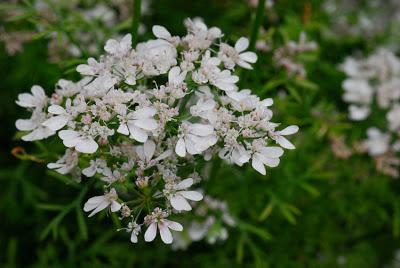 Once opened the flowers blow about and flutter in the slightest breeze, as they're sitting atop stems of very fine foliage. The seeds form about two to three weeks after the flowers.
Once opened the flowers blow about and flutter in the slightest breeze, as they're sitting atop stems of very fine foliage. The seeds form about two to three weeks after the flowers.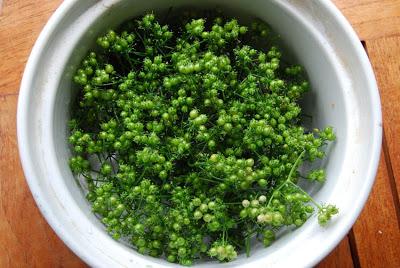 I'm keeping the seeds for two purposes. One is to use them for planting coriander next year. This year's crop was my best ever, and while it may simply have been kind weather, I'm not taking any chances. I want to grow this plant's babies. The rest of the dried seed will go into the kitchen, probably into something slow-cooked and either Greek or Moroccan.
I'm keeping the seeds for two purposes. One is to use them for planting coriander next year. This year's crop was my best ever, and while it may simply have been kind weather, I'm not taking any chances. I want to grow this plant's babies. The rest of the dried seed will go into the kitchen, probably into something slow-cooked and either Greek or Moroccan.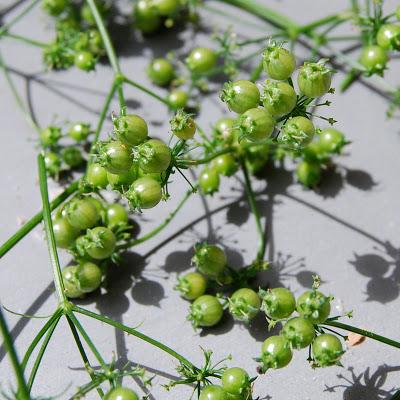 The seeds themselves are almost translucent, but not quite.
The seeds themselves are almost translucent, but not quite.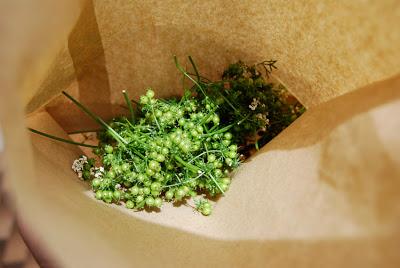 I did a bit of Googling and it seems the tried and tested paper bag method of drying seed is good enough for quite a few people, so that's what I'm doing.
I did a bit of Googling and it seems the tried and tested paper bag method of drying seed is good enough for quite a few people, so that's what I'm doing.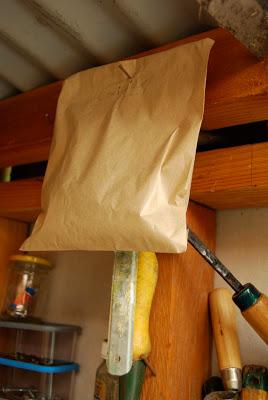 The brown paper bag hangs on a nail inside the shed, and hopefully the seeds will be dry in a few weeks, but I'm not in a hurry. The brown paper bag method worked well for the zinnia flower seeds I saved last autumn, so I can't see why it won't work for these coriander seeds too. Fingers crossed, though.
The brown paper bag hangs on a nail inside the shed, and hopefully the seeds will be dry in a few weeks, but I'm not in a hurry. The brown paper bag method worked well for the zinnia flower seeds I saved last autumn, so I can't see why it won't work for these coriander seeds too. Fingers crossed, though.Planting time for my next batch of coriander is next year, in April or May, once the summer is well and truly over and the cooler weather of autumn has arrived. Autumn, winter and early spring are the coriander growing season here.
